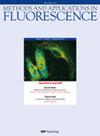石英玻璃表面大环氟离子载体共聚制备的用于常规荧光光谱仪的比色杯兼容Zn2+传感工具
IF 2.4
3区 化学
Q3 CHEMISTRY, ANALYTICAL
引用次数: 1
摘要
我们在这里报告了一种表面改性石英玻璃片的发展,它提供了一个机会,将传统的荧光光谱仪转换为离子选择性光化学传感器,通过对角线放置在光度比色皿中。此外,我们描述了一种可推广的技术,该技术允许使用任何可聚合的离子载体来开发各种选择性的多用途荧光化学传感器。将一种含烯丙基的荧光双(吖啶酮)冠醚与甲基丙烯酸酯-丙烯酰胺基单体混合物进行光催化共聚,得到了一层离子选择性传感膜层。这种基于玻璃膜的直接光电器件使Zn2+的检测下限超过2.2 × 10-7 mol·l−1,具有良好的可重复使用性。限制因素,如pH和竞争离子或有机剂进行了深入的研究。此外,还测量了加标的河水样本以证明其适用性。所提出的传感器放置在任何传统的荧光光谱仪中,为所有需要快速,易于使用,便携式和可再生分析仪的化学家提供了一种创新的无扰动分析Zn2+的方法,而不需要分析物专用仪器。本文章由计算机程序翻译,如有差异,请以英文原文为准。
A cuvette-compatible Zn2+ sensing tool for conventional spectrofluorometers prepared by copolymerization of macrocyclic fluoroionophores on quartz glass surface
We report here the development of a surface-modified quartz glass sheet, which affords an opportunity for converting conventional spectrofluorometers to ion-selective optochemical sensors by placing it diagonally into a photometric cuvette. Moreover, we describe a generalizable technique, which allows the usage of any polymerizable ionophores for developing multiple-use fluorescent chemosensors of various selectivity. A fluorescent bis(acridino)-crown ether containing allyl groups was photocatalytically copolymerized with a methacrylate-acrylamide-based monomer mixture to obtain an ion-selective sensor membrane layer on the surface of the cuvette-compatible glass sheet. This glass membrane-based direct optode enabled the analysis of Zn2+ above a lower limit of detection of 2.2 × 10–7 mol·l−1 with an excellent reusability. Limiting factors, like pH and competing ionic or organic agents were thoroughly investigated. Moreover, spiked river-water samples were measured to demonstrate applicability. The proposed sensor placed in any conventional spectrofluorometer provides an innovative method for perturbation-free analysis of Zn2+ for all the chemists in need of a fast, easy-to-use, portable and regenerable analyzer without the requirement of an analyte-specific instrumentation.
求助全文
通过发布文献求助,成功后即可免费获取论文全文。
去求助
来源期刊

Methods and Applications in Fluorescence
CHEMISTRY, ANALYTICALCHEMISTRY, PHYSICAL&n-CHEMISTRY, PHYSICAL
CiteScore
6.20
自引率
3.10%
发文量
60
期刊介绍:
Methods and Applications in Fluorescence focuses on new developments in fluorescence spectroscopy, imaging, microscopy, fluorescent probes, labels and (nano)materials. It will feature both methods and advanced (bio)applications and accepts original research articles, reviews and technical notes.
 求助内容:
求助内容: 应助结果提醒方式:
应助结果提醒方式:


